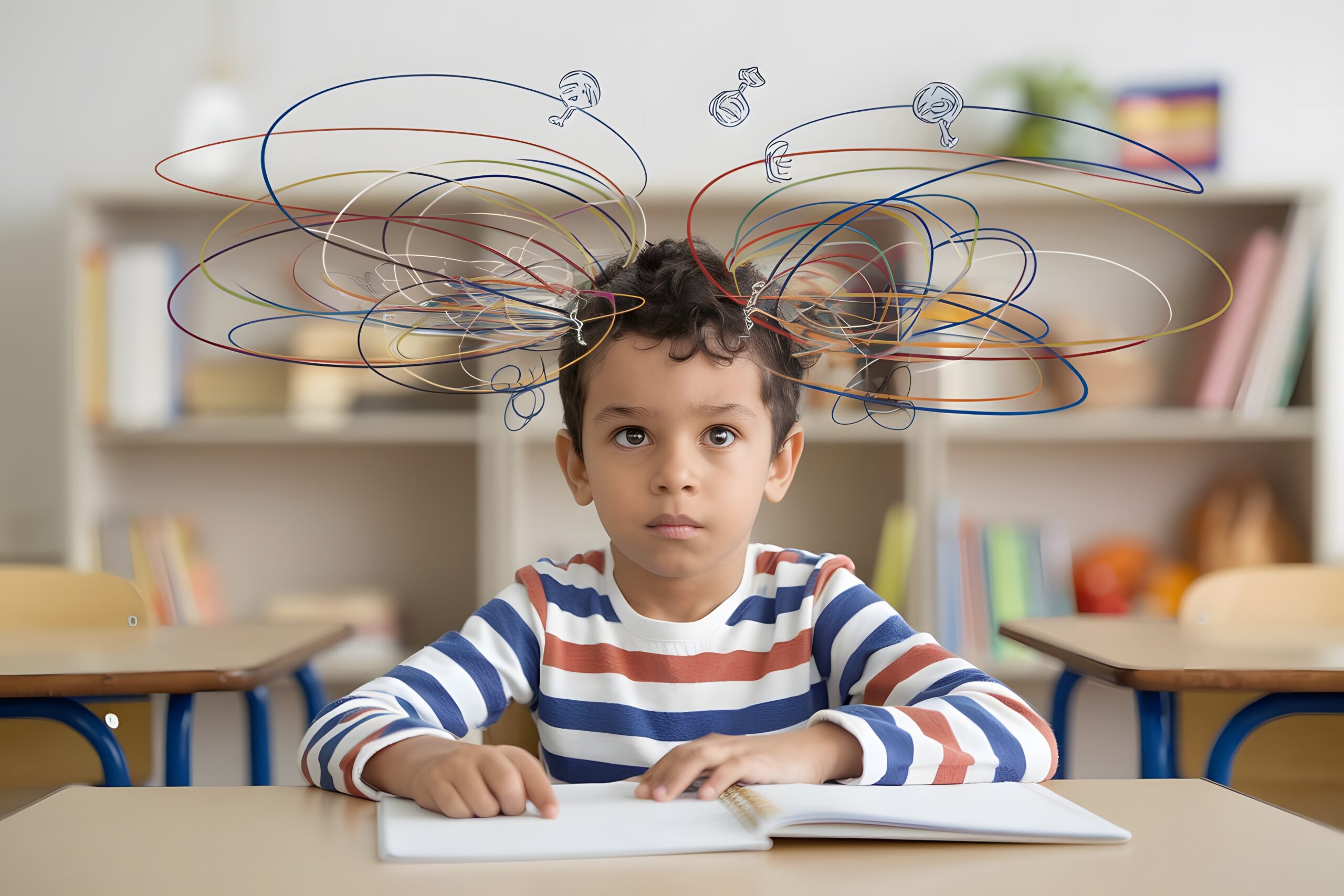A prevalent neurodevelopmental disorder in children is Attention-Deficit/Hyperactivity Disorder (ADHD). It usually manifests as either hyperactivity-impulsivity (fidgeting, acting without thinking), inattentiveness (difficulty focusing or following instructions), or a combination of both. Students with ADHD may find it challenging to succeed in a conventional school environment as a result of these symptoms.
School accommodations can help with that. Students with ADHD can get specialized support to help them thrive through a Section 504 plan or an Individualized Education Program (IEP). Additional time for exams, activity breaks, or assistance with organization are a few examples of these services.
The classroom’s layout and atmosphere are also quite important. A calm environment, clear instructions, and predictable routines can all have a significant impact.
Since every student with ADHD is unique, their support plans must be adaptable and updated as they develop and their needs shift. Above all, when teachers, parents, and students collaborate to develop a learning plan that genuinely suits each student, success occurs.
General Principles for ADHD Accommodations
Prioritizing the unique requirements of students with ADHD is crucial when developing accommodations for them. Every student is affected by ADHD in a different way; some may have trouble focusing, some with impulsivity, and some with both. Designing tactics that genuinely enhance students’ learning is made easier by seeing how they interact in the classroom.
Involving the learner in their personal support plan is a fundamental element. Students can actively use the resources that support their success once they are aware of their strengths and weaknesses. Over time, this increases confidence and self-awareness.
Additionally, it’s critical to present accommodations as constructive aids rather than as penalties or “special treatment.” Visual reminders, calm testing locations, and additional breaks should be viewed as instruments to level the playing field rather than as sanctions for misbehavior.
Lastly, adaptability is crucial. What is effective at the beginning of the year may need to be adjusted later. Ensuring that accommodations continue to meet the student’s changing needs and foster long-term success requires routine check-ins and adjustments.
Accommodations for Inattentive Symptoms
These pupils can remain on course and gain confidence in the classroom with the correct resources. Here are a few easy and efficient methods that schools may assist.
Classroom Seating & Focus Supports
A student’s seat in the classroom can have a significant impact. Daydreaming and zoning out might be lessened by positioning them close to the instructor or away from distractions like windows or entrances. Positive vibes can also be created by sitting next to a motivated, supportive classmate.
Teachers can gently refocus students’ attention without making them feel uncomfortable by using private cues, such as eye contact or a tap on the desk. Without creating tension, these tiny cues aid in regaining attention.
Instructional Strategies
Giving both written and spoken instructions is beneficial since students with inattentive symptoms frequently overlook oral instructions. Lessons can be made more understandable and interesting by using visual aids like charts, images, or diagrams.
Teachers can ask students to repeat instructions in their own terms to see if they comprehend. This easy technique helps avoid misunderstandings before work starts.
Task Structuring
Dividing big tasks into smaller ones makes them easier to do because they can feel daunting. Teachers can assist students in maintaining focus and time awareness by using timers or alarms.
Another helpful accommodation is more time for examinations or assignments, which enables the student to work at their own speed without undue pressure.
Environmental Tools
Using privacy boards or testing in a quiet area helps reduce distractions while working on crucial tasks. Students can also remain on task by using digital tools like tablets and apps or by organizing things in colorful folders.
Last but not least, allowing students to take brief movement breaks throughout the day allows them to recharge and concentrate, which facilitates their ability to return to their work with clarity.
Accommodations for Hyperactive-Impulsive Symptoms
It might be difficult for students with hyperactive-impulsive ADHD to wait their turn, remain quietly, or think things through before acting. These actions are simply a function of their minds and have nothing to do with disrespect. These children can maintain their interest in learning and find constructive outlets for their energy with the correct assistance. These are some useful tactics that schools can implement.
Behavioral Supports
Impulsivity frequently causes little disturbances, such as blurting out or tapping a pencil. Ignoring small actions that don’t harm anyone and concentrating on redirecting when necessary can often be beneficial. To keep the student on course without calling attention to themselves, use verbal or visual cues in private, such as a hand gesture or a soft reminder.
It’s critical to acknowledge and commend pupils when they exhibit good behavior, such as raising their hands or waiting their time. In order to develop positive habits, a little encouragement goes a long way.
Classroom Modifications
Students who need to move about don’t always benefit from traditional desks. Options for flexible seating, such as wiggle cushions or standing desks, can be beneficial. Students can release their energy without disrupting the class by using silent movement techniques, such as squeezing a stress ball, or fidget toys.
Stretch breaks and regular exercise throughout the day allow students to get up and refocus, especially in lengthy classes.
Instructional Techniques
Students who are constantly on the go benefit most from hands-on learning. Building, moving, and interacting activities keep kids interested. They can also be paired with targeted peer role models to assist direct engagement and behavior.
It may be simpler for these kids to communicate what they know if spoken responses are permitted rather than written ones. Additionally, minimizing repetitive tasks and ensuring that they are difficult yet manageable assist prevent boredom and restlessness.
Structure & Routine
Students with hyperactivity benefit from having clear routines because they know what to expect. Turn-taking can be taught in a systematic and enjoyable way by using resources like speaking tokens during group discussions.
Furthermore, these students actually require the most movement time, despite the temptation to eliminate recess as a punishment. Recess is a far better approach to promote their behavior and learning than to remove it from their day.
Combined-Type ADHD: Sample Accommodations
Known as Combined-Type ADHD, some students exhibit both hyperactive-impulsive and inattentive symptoms. These pupils may find it difficult to concentrate and remain still, or they may complete assignments quickly while also having difficulty following instructions.
Their accommodations must include techniques that address behavior and attention since they face a variety of difficulties. Here are a few examples of helpful ways to help these students.
- Blended Strategies for Mixed Behaviors
Giving kids flexible work alternatives, such as allowing them to select between typing and handwriting, can help them stay motivated and less frustrated. Students can refuel and return to longer chores or classes with more focus when scheduled breaks are taken.
Private cues, such as a hand signal or sticky note, can be used to gently redirect attention or behavior without calling it out in public. Seating should be distant from busy areas to minimize distractions.
Students can maintain concentration without feeling overburdened when assessments are divided into manageable chunks. Allowing them more time guarantees that they are not hurried and that they have an equal opportunity to demonstrate their knowledge.
Academic-Specific Accommodations
Numerous learning domains, including writing, math, and assignment management, can be impacted by ADHD. Students with ADHD are frequently intelligent and creative, so it’s not that they lack brains; rather, they might require various methods and resources to demonstrate their knowledge. By removing barriers, academic accommodations enable students to concentrate more on their studies and less on controlling their dissatisfaction.
Written Work
Offering students who have trouble writing the opportunity to turn in projects digitally or give oral reports can have a significant impact. Some people might benefit from shorter assignments that nevertheless evaluate important skills, while they might require longer time to complete tasks.
Students may focus on ideas rather than mechanics and experience less stress when they use computers with grammar and spell check. Additionally, even if cursive might be challenging, printing ought to be acknowledged as a legitimate substitute that enables kids to finish their assignments with ease.
Math Support
Students with ADHD may find math challenging, particularly if it requires a lot of steps or memorization. Errors and distractions can be decreased by allowing calculators and offering photocopied problems rather than ones that are copied off the board.
Key concepts are reinforced and comprehension is supported by visual aids, practical examples, and review sheets. Students can perform better without feeling overburdened by decreasing complicated multi-step tasks or granting them more time on math assessments.
Homework & Organization
For many students with ADHD, maintaining organization is a major issue. Assignment notebooks and daily planners are useful tools, particularly when used in conjunction with instructor check-ins. Some people find that using a device to record homework reminders works better than writing them down.
Students (and families) find it easier to manage assignments when less documentation is sent home. Giving pupils extra textbooks to utilize at home also helps to guarantee that they have everything they need, even in the event that they fail to bring supplies with them.
Behavior and Emotional Regulation Support
Schools can assist these pupils in maintaining composure, concentration, and emotional equilibrium by providing the appropriate resources. By guiding rather than punishing, these techniques aim to make the classroom a more encouraging and effective environment for everybody.
Impulsivity Management
Physical impulsivity can be decreased by making little changes like extending the distance between desks or marking a student’s personal space with tape. Dealing with pupils’ outbursts in a discreet and quiet manner preserves their self-worth and fosters trust.
Students are given clear expectations and a goal to strive for through behavior contracts and reward systems. Small incentives for achieving objectives can have a significant impact on motivation to stick to a schedule.
Disruption Reduction
Students can release pent-up energy through controlled doodling or sensory play (such as with a stress ball or textured object) without upsetting other people. A dedicated calm-down area in the classroom provides a secure means for stressed-out pupils to decompress and come back prepared to study.
Daydreaming & Attention Cues
Teachers can employ playful verbal cues like “Freeze” or “Eyes on me” to get a distracted pupil to focus again. These cues are captivating and can attract attention fast without becoming embarrassing.
Allowing pupils to have a brief “zone-out” period after finishing a task can occasionally be beneficial. In addition to providing them with a mental respite, it can enhance their general focus.
During courses, visual aids like spotlights or laser pointers can also help focus attention, particularly for pupils who are more receptive to nonverbal clues. Students with ADHD can benefit greatly from these minor but well-considered changes in behavior and emotional regulation.
Social Skills Development
These adolescents can form enduring bonds and feel closer to their peers with a little help and direction. Here are some strategies for schools to support the social and emotional development of students with ADHD.
Peer Interaction & Inclusion
Students can practice sharing, listening, and cooperating with others in a safe environment by setting up small social skills groups. Students gain confidence and get ready for real-world scenarios through these programs.
Cooperative learning activities, in which students work in groups, can help students with ADHD connect in the classroom. Assigning them leadership responsibilities in group projects also helps them feel better about themselves and demonstrates to their peers what they are capable of.
Positive Reinforcement
Regular, targeted praise makes a big difference. Positive habits are formed and expectations are reinforced when positive acts are acknowledged and named, such as “Thanks for waiting your turn” or “Excellent teamwork today.”
Acknowledging a student’s assets, such as their inventiveness, humor, or helpfulness, can foster respect among peers and demonstrate that they are appreciated despite their difficulties.
Communication & Self-Regulation
Students with ADHD can misread social signs, interrupt, or talk out of turn. They can think back on these experiences without feeling ashamed when they use private feedback.
Over time, students’ self-regulation and communication skills can be enhanced by encouraging them to reflect on their actions, including what went well, what didn’t, and what they might do better the next time. These brief comments support students’ social and emotional development in addition to their academic growth.
Classroom Management Strategies
All children, even those with ADHD, benefit from a supportive environment created by a well-run classroom. Students are better able to focus and feel safe when routines are explicit, distractions are minimal, and expectations are constant. Teachers may help children with ADHD while also helping the class as a whole by implementing these easy yet powerful tactics.
Establish clear routines, rules, and expectations
When they know what to expect, students with ADHD do well. Anxiety and confusion can be lessened by having a regular daily schedule and explicit classroom rules. Students find it simpler to stay on course when there are visual schedules, rules posted, and frequent reminders.
Minimize distracting visual clutter
It can be overpowering to have too many posters, garish decorations, or disorganized bulletin boards. Students with ADHD can concentrate better on courses and instructions in a classroom that is organized and peaceful.
Plan lessons to reduce downtime and transitions
Disruptive behavior or restlessness might result from unstructured time. Students remain interested and have less opportunities for distraction when classes are kept moving, interesting activities are used, and task transitions are planned smoothly.
Maintain consistent monitoring and awareness of classroom dynamics
Teachers can avoid issues by responding quickly and calmly to students’ demands and misbehavior. Maintaining a smooth classroom can be achieved through subtle redirection, rewarding good behavior, and recognizing when a kid needs a break.
Conclusion: Supporting ADHD Students in the Classroom
There is no one-size-fits-all approach to helping students with ADHD; rather, it involves combining structure, adaptability, and compassion to suit each student’s particular requirements. The best accommodations allow for movement, creativity, and individualized learning methodologies while maintaining clear routines.
Ongoing observation and cooperation between educators, parents, and students are equally crucial. Students feel noticed, supported, and understood when criticism is given freely and modifications are done thoughtfully. Giving kids the proper resources, sincere encouragement, and chances to participate in their own education fosters self-assurance and independence, two qualities that are essential for long-term success.
Every child should have access to a fair and encouraging learning environment, in our opinion at K Altman Law. Our staff is available to support you and defend your child’s educational rights, whether you need assistance negotiating IEPs, 504 plans, or fighting for suitable accommodations.




